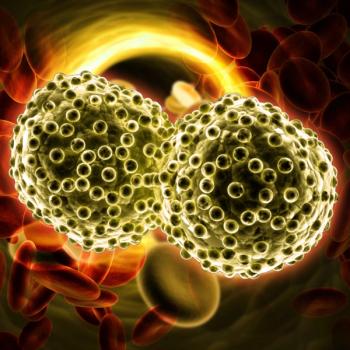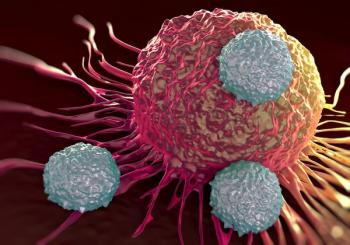
Oncology NEWS International
- Oncology NEWS International Vol 12 No 1
- Volume 12
- Issue 1
Gram+ Infections Predominate in Neutropenic Pts
SAN DIEGO, California-Researchers at the Jones Group/JMI Laboratories, North Liberty, Iowa, have confirmed that Gram-positive pathogens predominate in neutropenic cancer patients with infections. The study also found that these organisms are no more likely to be resistant to available drugs in the cancer population than in the general population. They presented the results of the first year of the study in two poster presentations at the 43rd Annual Inter-science Conference on Antimicrobial Agents and Chemotherapy (ICAAC abstracts C2-290 and C2-296).
SAN DIEGO, CaliforniaResearchers at the Jones Group/JMI Laboratories, North Liberty, Iowa, have confirmed that Gram-positive pathogens predominate in neutropenic cancer patients with infections. The study also found that these organisms are no more likely to be resistant to available drugs in the cancer population than in the general population. They presented the results of the first year of the study in two poster presentations at the 43rd Annual Inter-science Conference on Antimicrobial Agents and Chemotherapy (ICAAC abstracts C2-290 and C2-296).
The 3-year longitudinal surveillance study, known as the Chemotherapy Alliance for Neutropenics and Control of Emerging Resistance (CANCER) Program, was founded in 2001 to monitor resistance in antimicrobial and antifungal therapies used for oncology patients. Thirty-two oncology centers, hospitals, and clinics from the United States and Canada submitted 2,042 isolates (1,992 bacterial and 50 yeast) to JMI Laboratories for testing against 41 antimicrobial agents. The study is being funded by the Wyeth Pharmaceutical Company.
According to Jeff Kirby, a medical technologist with JMI Laboratories, during the last 2 decades, a significant change has occurred in the prevalence of bacterial organisms in oncology patients with neutropenia. Where once Gram-negative pathogens dominated, Gram-positives are now in the majority. "One reason is that when Gram-negatives are prevalent, pharmaceutical companies will target those and produce drugs that are effective," Mr. Kirby said. "As the Gram-negatives are killed effectively, there is a rise on the other side."
In this first year of the study, researchers found that 53% of the bacterial isolates submitted were Gram-positive organisms. The top five pathogens overall were Staphylococcus aureus (18.1%), Escherichia coli (14.3%), coagulase-negative staphylococci (14.1%), Enterococcus spp (9.9%), and Klebsiella spp (9.6%). The top five Gram-positive pathogens were S aureus (18.1%), coagulase-negative staphylococci (14.1%), Enterococcus spp (9.9%), Streptococcus viridans (3.5%), and Streptococcus pneumoniae (2.6%).
"The critical question is, are the drugs we use to treat Gram-positive isolates as effective today as they were previously, and will they be effective in the future?" said Alan Mutnick, PharmD, director of pharmacology, The Jones Group/JMI Laboratories.
Given the reports of problems with vancomycin resistance, researchers were pleasantly surprised with the first-year results, Dr. Mutnick said. "Vancomycin, the old drug, along with quinupristin/dalfopristin [Synercid], a relatively new drug, and linezolid [Zyvox], the newest drug, all had excellent activity against the Gram-positive isolates," he said.
Dr. Mutnick hopes that the study may help dispel some of the myths about vancomycin as a "lost drug" that isn’t useful anymore. "Sometimes old drugs still do work," he said. "Also, we need to take care to use the newer agents in the most effective fashion. Otherwise, today’s new agents will become tomorrow’s resistance problems."
Linezolid displayed the broadest coverage99.5% to 100% susceptibilityagainst the top five Gram-positive pathogens, with no resistance. Linezolid was the only agent with satisfactory coverage against all species of Enterococcus.
Vancomycin and quinupristin/dalfo-pristin paralleled linezolid’s activity against most Gram-positive isolates, with susceptibilities ranging from 98.9% to 100% against S aureus, coagulase-negative staphylococci, S viridans, and S pneumoniae, and no resistant isolates among those pathogens.
Garenoxacin, Bristol-Myers Squibb’s investigational desfluoroquinolone, compared favorably to gatifloxacin (Tequin), with Gram-positive susceptibility rates of 81% to 90% vs 78% for gatifloxacin.
"The results of this first-year, benchmark study for the CANCER Program was that the Gram-positive pathogens were not more resistant in cancer patients, as compared with other hospital patient populations," Mr. Kirby concluded. "They were actually very susceptible."
Articles in this issue
almost 23 years ago
Phase II Trial of Phenoxodiol in Recurrent Ovarian Cancer Is launchedalmost 23 years ago
FDA Approves New Taxotere Indication as First-Line Therapy for NSCLCalmost 23 years ago
Most Cancer Pain Is Experienced at the Patient’s Homealmost 23 years ago
HHS Unites Its HIV Advisorsalmost 23 years ago
First NCI Health Disparity Grantsalmost 23 years ago
Pain Therapy Improves Quality of Life for Caregiversalmost 23 years ago
Inex to Seek FDA Approval for Onco TCS (Liposomal Vincristine)almost 23 years ago
CD40L-Expressing Dendritic Cells Eliminate Breast Tumors in Micealmost 23 years ago
Safe Handling Tips for Use of Testosterone Gelalmost 23 years ago
Lumpectomy/Mastectomy Equivalent in Early Breast CancerNewsletter
Stay up to date on recent advances in the multidisciplinary approach to cancer.















































































